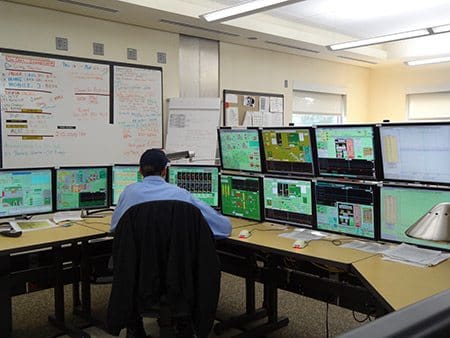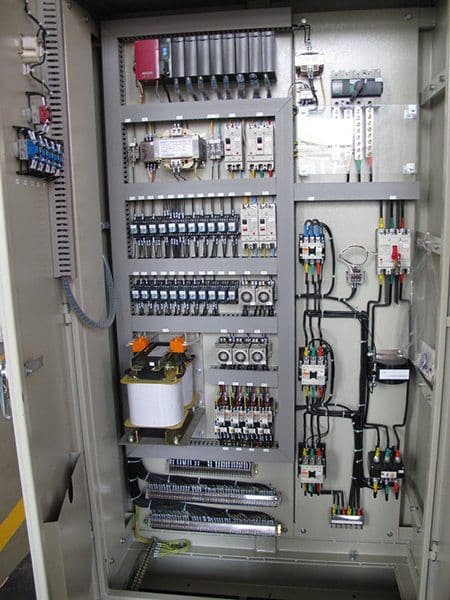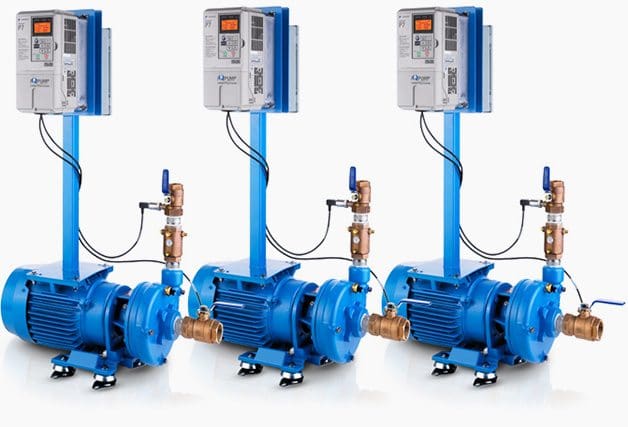Detailed energy assessment
Pump systems consist of pumps, driver, pipe installation and controls (such as ASDs or throttles) and are a part of the overall motor system. Below some of the energy efficiency opportunities for the pumping system are presented.

Also, American Society of Mechanical Engineers (ASME) has published a standard that covers the assessment of pumping systems, which are defined as one or more pumps and those interacting or interrelating elements that together accomplish the desired work of moving a fluid.
In this standard the procedure of conducting a 14 detailed energy assessment of the pumping system as well as the energy efficiency opportunities are described.
- Maintenance
- Monitoring
- Controls
- Reduction of demand
- More efficient pumps
- Proper pump sizing
- Multiple pumps for varying loads
- Impeller trimming (or shaving sheaves)
- Adjustable speed drives (ASDs)
- Avoiding throttling valves
- Proper pipe sizing
- Replacement of belt drives
- Precision castings, surface coatings or polishing
- Improvement of sealing
1. Maintenance
Inadequate maintenance lowers pump system efficiency, causes pumps to wear out more quickly and increases costs. Better maintenance will reduce these problems and the most important – to save energy.

Proper maintenance includes the following:
- Replacement of worn impellers, especially in caustic or semi-solid applications.
- Bearing inspection and repair.
- Bearing lubrication replacement, once annually or semiannually.
- Inspection and replacement of packing seals.
- Inspection and replacement of mechanical seals.
- Wear ring and impeller replacement.
- Pump/motor alignment check.
- The largest opportunity is usually to avoid throttling losses.
Typical energy savings for operations and maintenance are estimated to be between 2% and 7% of pumping electricity use for the U.S. industry. The payback usually is less than one year.
2. Monitoring
Monitoring in conjunction with operations and maintenance can be used to detect problems and determine solutions to create a more efficient system. Monitoring can determine clearances that need be adjusted, indicate blockage, impeller damage, inadequate suction, operation outside preferences, clogged or gas-filled pumps or pipes, or worn out pumps.

Monitoring should include:
- Wear monitoring
- Vibration analyses
- Pressure and flow monitoring
- Current or power monitoring
- Differential head and temperature rise across the pump (also known as thermodynamic monitoring)
- Distribution system inspection for scaling or contaminant build-up
3. Controls
The objective of any control strategy is to shut off unneeded pumps or to reduce the load of individual pumps. Remote controls enable pumping systems to be started and stopped relatively quickly and accurately, and reduce the required labor with respect to traditional control systems.

4. Reduction of demand
Holding tanks can be used to equalize the flow over the production cycle, enhancing energy efficiency and potentially reducing the need to add pump capacity. In addition, bypass loops and other unnecessary flows should be eliminated.
Total head requirements can also be reduced by lowering process static pressure, minimizing elevation rise from suction tank to discharge tank, reducing static elevation change by use of siphons and lowering spray nozzle velocities.

5. More efficient pumps
Pump efficiency may degrade 10% to 25% in its lifetime. Industry experts however point out that this degrading performance is not necessarily due to the age of the pump but can also be caused by changes in the process which may have caused a mismatch between the pump capacity and its operation.
Nevertheless, it can sometimes be more efficient to buy a need pump, also because newer models are more efficient.
Exceptions include slurry handling pumps, high specific speed pumps or in applications where the pump needs a very low minimum net positive suction head at the pump inlet.

Replacing a pump with a new efficient one reduces energy use by 2% to 10%. Higher efficiency motors have been shown to increase the efficiency of the pump system 2% to 5%.
6. Proper pump sizing
A pump may be incorrectly sized for current needs if it operates under throttled conditions, has a high bypass flow rate, or has a flow rate that varies more than 30% from its best efficiency point flow rate (U.S. DOE-OIT, 2005). Where peak loads can be reduced, pump size can also be reduced. A smaller motor will however not always result in energy savings, as these depend on the load of the motor.
Only if the larger motor operates at a low efficiency, replacement may result in energy savings. Pump loads may be reduced with alternative pump configurations and improved operations and management practices.
When pumps are dramatically oversized, speed can be reduced with gear or belt drives or a slower speed motor. This practice, however, is not common. Paybacks for implementing these solutions are less than one year. Oversized and throttled pumps that produce excess pressure are excellent candidates for impeller replacement or “trimming,” to save energy and reduce costs.

Correcting for pump oversizing can save 15% to 25% of electricity consumption for pumping (on average for the U.S. industry).
7. Multiple pumps for varying loads
The use of multiple pumps is often the most cost-effective and most energy-efficient solution for varying loads, particularly in a static head-dominated system. Alternatively, adjustable speed drives could be considered for dynamic systems. Parallel pumps offer redundancy and increased reliability.
8. Impeller trimming (or shaving sheaves)
Trimming reduces the impeller’s tip speed, which in turn reduces the amount of energy imparted to the pumped fluid; as a result, the pump’s flow rate and pressure both decrease.
A smaller or trimmed impeller can thus be used efficiently in applications in which the current impeller is producing excessive heat. In the food processing, paper and petrochemical industries, trimming impellers or lowering gear ratios is estimated to save as much as 75% of the electricity consumption for specific pump applications.
9. Adjustable speed drives (ASDs)
ASDs better match speed to load requirements for pumps. As for motors, energy use of pumps is approximately proportional to the cube of the flow rate9 and relatively small reductions in flow may yield significant energy savings. New installations may result in short payback periods.
Similar to being able to adjust load in motor systems, including modulation features with pumps is estimated to save between 20% and 50% of pump energy consumption, at relatively short payback periods, depending on application, pump size, load and load variation.

As a general rule of thumb, unless the pump curves are exceptionally flat, a 10% regulation in flow should produce pump savings of 20% and 20% regulation should produce savings of 40%.
10. Avoiding throttling valves
Variable speed drives or on-off regulated systems always save energy compared to throttling valves. The use of these valves should therefore be avoided. Extensive use of throttling valves or bypass loops may be an indication of an oversized pump.

11. Proper pipe sizing
Energy may be saved by reducing losses due to friction through the optimization of pipe diameters. The frictional power required depends on flow, pipe size (diameter), overall pipe length, pipe characteristics (surface roughness, material, etc.), and properties of the fluid being pumped.

Correct sizing of pipes should be done at the system design stages where costs may not be restrictive.
12. Replacement of belt drives
Most pumps are directly driven. However, some pumps use standard V-belts which tend to stretch, slip, bend and compress, which lead to a loss of efficiency. Replacing standard V-belts with cog belts can save energy and money, even as a retrofit.
13. Precision castings, surface coatings or polishing
The use of castings, coatings or polishing reduces surface roughness that in turn, increases energy-efficiency. It may also help maintain efficiency over time. This measure is more effective on smaller pumps.
14. Improvement of sealing
Seal failure accounts for up to 70% of pump failures in many applications. The sealing arrangements on pumps will contribute to the power absorbed. Often the use of gas barrier seals, balanced seals, and no-contacting labyrinth seals can help to optimize pump efficiency.

Reference: Industrial Energy Audit Guidebook: Guidelines for Conducting an Energy Audit in Industrial Facilities – Ali Hasanbeigi, Lynn Price











Articles are very useful in maintenance work of electro-mechanical equipments.
Please inform on energy savings in Thermal Power Stations, for, Boilers, cooling towers, WTP, STP, ETPs,
I’m electrical engineer I have already work for hyatt hotel construction electrical site engineer
I am interested….I am an Mechanical Engineer….
Good information..!